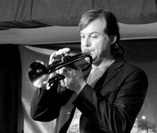|
I have custom fit thousands of trumpet players to new mouthpiece configurations. And I have gained a wealth of knowledge from those very same clients. They taught me what works for one person may not work for anyone else. And what works for most is really just a mediocre average that could easily be improved upon on an individual basis. The most important lesson from working with such a diverse cross section of our industry? Every single person is different and reaching your potential requires much more than dedicated practice and passion. Some of you will disagree with just about everything you will see in today's video... Comments, criticism and questions are welcome!
1 Comment
Having built a brand from the ground up, I have devoted a fair amount of time and energy to this question. I began experimenting with trumpets and, what eventually became known as Standing Wave Efficiency, in 1992. My first experiment involved soldering weight to a set of Bach Stradivarius bottom caps to reduce anti-nodal vibrations on specific partials. My friends though I was crazy. And my parents did not approve of defacing my prized possession, the Bach 37 built 30 years prior, which they gave to me for a high school graduation gift. In complete disregard to all warnings, I began disassembling the Bach brand name by disassembling Bach professional trumpets.
For the previous few years, it had been drilled into my head that all great trumpet players only perform on Bach trumpets because they are the best. This "fact" was something I never questioned. My band director told me that Bach was the best and it seemed true considering all the best players I knew at the time also played on Bach. This brand name was synonymous with the best available brass instruments. My perspective changed after I was given my first Bach Strad 37 a few months before setting off to music school to pursue a Bachelor's of Music degree in Trumpet Performance. My Dad had purchased my particular Bach 37 from my uncle and it was in need of repair. He spent his savings having it refurbished to "like new" condition in clear lacquer before giving it to me. When I opened the case, I was amazed at how new the horn looked even though it was built in the 1960's. I knew that my level of performance would improve immediately because I know held the holy grail of trumpets! Fast forward three months to auditions for Band and Orchestra in college. I'm struggling to play my audition pieces as well as I did on an old beat up cornet that had been lent to me from my grade school music teacher since 5th grade. I could not for the life of me reach wide intervals as easily and my tone became distorted and harsh as much lower dynamics than I had remembered. I was convinced that the problem was me and never once considered that my Bach trumpet could be holding me back. In fact, I was completely disappointed in myself for letting down my family who worked so hard to buy me this instrument. How could I be failing with this amazing Bach trumpet in my hands? The surprise of my life came during that week of auditions. And the next events changed the course of my career and trumpet design as we know it worldwide. As I was standing outside the audition room giving my chops a break from practicing, I met another freshman trumpet player also auditioning for the Symphonic Band that day. His name was Dave and he has been one of my best friends ever since. Dave asked me about my horn as he immediately recognized it was built decades earlier than his brand new 1992 Bach Stradivarius 37 finished in polished silver plate. To make a long story short, we exchanged horns and both returned to our practice rooms to test them. In my mind, I was thinking that both horns are the same model, but Dave's horn is in silver so it will probably sound brighter than my horn. I had been working on the Hindemith Sonata, which is a very dark piece full of emotional outbursts in the form of wide interval leaps, sudden dynamic changes, bold statements and after thoughts to be executed with very light finesse. I played the first two lines and was in complete disbelief! Dave's Bach soared on every note in a way that allowed me to phrase on a musical level I had never before achieved. It was not overly bright, but mature, vibrant, dark, warm and brilliant all at the same time. This horn was alive in my hands and I felt like a wizard who had discovered a spell that gave my trumpet playing an operatic voice. I was in love with this horn. A few minutes later, Dave knocked on my practice room door and hand my old, but somewhat new, Bach to me and said something to the affect of, "yeah, I've heard great things about those vintage Bach trumpets, but I don't see why anyone would want one." And I couldn't agree with him more. My horn was a dud. It did not resonate like his horn and I found myself, for the first time in my life, questioning the brand name Bach. How could one Stradivarius play so amazingly well and the other play so very, well let's just say not amazing in any way? The guilt began to set in. My Dad spent all of his money buying and refurbishing that Bach trumpet so I could succeed as a musician. I felt terrible as I now understood that his money was spent on something that did not live up to the name. Bach was no synonymous with questionable quality, sometimes amazing and other times not good at all. I was crushed. And I had an audition in 15 minutes! to be continued... Having working with thousands of trumpet players over the years, I'm often asked for advice regarding range, endurance, tone, technique, etc. However, I am very rarely asked about mouthpiece pressure. In reality, most trumpet players' concerns are directly related to the space between the mouthpiece and teeth. Rather than focus on mouthpiece "pressure", I prefer to discuss the distance required to vibrate the lips. This video will guide you through concepts that may seem completely new, yet directly related to our overall performance success.  I'm asking you personally, what is your greatest challenge as a musician? Is it finding the time to practice? Or maybe it's connecting with the right musicians to make an ensemble really click? This question has driven much of my life since I was in high school back in the late 80's. Once I got hooked on playing trumpet, I found myself running into more and more challenges that were seemingly beyond my capacity. I wanted to play high, fast and loud like many others, but my greatest goal at the time was simply making beautiful music that would captivate any and all listeners. You see, my challenge was embouchure. I suffered loose teeth and mangled lips due to excessive mouthpiece pressure and I would have done anything to correct this issue. As a young man, I became obsessed with overcoming my challenges on trumpet and helping my colleagues with the same. First, I studied the physics of brass playing and corrected my embouchure. Then I studied the physics of brass instruments and redesigned the trumpet hundreds of times in search of the perfect balance between efficiency and resonance. Then I studied the psychology of trumpet players to eventually create the world's only mouthpiece with modular cup and throat variations both in dimension and shape. Yes, this innovation is directly related to the psychology of how trumpet players hear themselves! And this led to introducing the variable performance system (VPS) allowing complete adjustment of flexibility, slotting, air flow, and resonance. What is my greatest challenge as a trumpet player today? Finding the time to practice and perform! Take a few seconds to think about your three greatest challenges as a brass player? Write these down. What if I could help you with just one item on your list? Would you want to learn something new that may lead to you overcoming that challenge? Are you willing to learn something new? I can only help you if you are truly interested in breaking your paradigm. I've done this for thousands of trumpet players over the past 25 years. And I wake up every morning excited to get into the shop or showroom to work directly with my clients on their challenges. In fact, it was working with so many amazing people that led to my own success as a musician, inventor, trumpet designer and brass coach. I'm ready to help you tackle the first challenge on your list. Comment below and share what you would like to do better so that your audience will be entranced by your next performance. |
Jason Harrelson
Inventor, Musician, Educator and Founder of Harrelson Trumpets, Trumpet Momentum and Harrelson Momentum. Archives
July 2024
|

 RSS Feed
RSS Feed
